I enjoyed waking up this morning and surveying my hotel moon base.
I pondered whether a building like this counted as a tent. It seemed sort of like if you built a house but instead of covering it in siding you just had your grandmas knit a quilt around the outside. Is that a tent or what?
The landscape out here was pretty great.
We took a picture next to this sign but as we had not really seen Petra yet I did think it was a bit early to commit to hearting Petra.
Before we started planning this trip I knew zero about Petra other than the fact it was featured in 1989's Indiana Jones and the Last Crusade. I'd since read a lot more about the place and learned about the civilization that built it. Petra was really cool and one of those places that is better than advertised. Maybe because I rarely see it advertised but the main draw, Al-Khazneh from the movie scene, is only one small part of a large city full of stuff to see. I think we could have come back for a second full day without repeating anything.
Ali was with us for a good chunk of time and then set us loose in the ruins.
Djinn Blocks
Lonely Planet:
"About halfway between Petra Visitor Centre and the entrance to the Siq, look out for three enormous, squat monuments, known as Djinn Blocks or God Blocks. Standing guard beside the path, they take their name from the Arabic word for spirit, the source of the English word 'genie'. Other than the fact they were built by Nabataeans in the 1st century AD, little is known about their why or wherefore."
I think it's a fun sort of life lesson that anytime you have an amazing ancient structure in your head, be it the great pyramid or the famous treasury at Petra, a lot of trial and error happened before those amazing finished products could be created. They are testaments to the importance of perseverance, making mistakes, and learning by doing. Petra was teeming with carved structures.
Petra was also cool because you could see the trading city's confluence of great civilizations' cultures. The architectural style of the Nabataeans was a blend of Assyrian, Egyptian, Hellenistic, and Roman influences that were incorporated into the unique architecture of Petra.
I believe the jagged inverse triangle on the structure on the right there is Assyrian influence.
Obelisk Tomb & Bab as-Siq Triclinium
Lonely Planet:
"Between the Petra Visitor Centre and the entrance to the Siq (south side of the path), there is a fine tomb with four pyramidal obelisks, built as funerary symbols by the Nabataeans in the 1st century BC. The four obelisks, together with the eroded human figure in the centre, probably represent the five people buried in the tomb.
The obelisk tomb at first appears to be multistorey. In fact, it was built on top of a much earlier structure, with a Doric columned facade. This building is known as a triclinium (dining room), and is one of several in Petra. This is where annual feasts were held to commemorate the dead, although it’s hard to imagine the conviviality of a banquet in the silent hollow that remains."
"Camel Caravan Reliefs
100-50 BC
In front of you is a monumental relief, about a third larger than life, which depicts an actual caravan in procession. It consists of a group of camels and drivers entering Petra. About ten meters further up, there is a similar carving of a caravan leaving Petra, but this is more eroded. These caravans symbolize the endless procession of people and goods entering and leaving Petra, the economy of which was based on caravan trade. The first camel in this procession has a high hump, indicating that it is a caravan carrying goods. Close inspection of the upper group reveals that the lead driver, whose figure is preserved from the waist down, is clad in a loosely pleated cloth garment of wool. He holds a stick in his bent left arm with which to guide the animals."
Since much this city existed in between the walls of a canyon, they had to figure out ways to control and collect the occasional rainfall. There was a lot of ancient plumbing visible along the walls.
That first glimpse of something amazing that you've been anticipating is electric.
The Treasury
Lonely:
"Known locally as Al Khazneh, this tomb is where most visitors fall in love with Petra. The Hellenistic facade is an astonishing piece of craftsmanship. Although carved out of iron-laden sandstone to serve as a tomb for the Nabataean King Aretas III (c 100 BCE–CE 200), the Treasury derives its name from the story that an Egyptian pharaoh hid his treasure here (in the facade urn) while pursuing the Israelites.
Some locals clearly believed the tale because the 3.5m-high urn is pockmarked by rifle shots. As with all rock-hewn monuments in Petra, the interior is unadorned."
You can see two lines of holes in the rock on either side of the tomb, which is where they had scaffolding in place. The holes stop about midway up which is where the sand line was.
Petra was like a tourist shooting gallery. Every inch of ground was a shop or a restaurant or a man on a mule trying to sell you a ride. Walking up to a cliff to take a picture of the treasury was 5 dinar($7). I tried to negotiate a better price with a group of 4 of us and he just said “no my friend”. To their credit they were pretty good about taking no for an answer, but there were so many people selling the same things that I had to say no to the same scarf about 40 times.
Ali corralled us into a couple of fish barrels for easier shooting. One was a guy making sand sculptures in bottles. I was tempted because they were actually kind of cool but I didn't want to have to deal with transporting the thing.
Lonely:
"Originally built by the Nabataeans (not the Romans) more than 2000 years ago, the Theatre was chiselled out of rock, slicing through many caves and tombs in the process. It was enlarged by the Romans to hold about 8500 (around 30% of the population of Petra) soon after they arrived in 106 CE. Badly damaged by an earthquake in 363 CE, the Theatre was partially dismantled to build other structures but it remains a Petra highlight.
The seating area had an original capacity of about 3000 in 45 rows of seats, with three horizontal sections separated by two corridors. The orchestra section was carved from the rock, but the backdrop to the frons scaenae (stage, which is no longer intact) was constructed, as opposed to carved, in three storeys with frescoed niches and columns overlaid by marble. The performers entered through one of three entrances, the outlines of which are still partially visible.
To make room for the upper seating tiers, the Romans sliced through more tombs. Under the stage floor were storerooms and a slot through which a curtain could be lowered at the start of a performance. From near the slot, an almost-complete statue of Hercules was recovered."
Another amazing commercial opportunity was Jack Sparrow selling the local eyeliner. The Bedouins make kohl, an eye-liner powder substance made from coal, olive oil, and herbs.
Lydia is unimpressed with incense dealers every since I showered her with Omani frankincense and myrrh like a very lucky baby Jesus.
"Downhill from the Theatre, the Colonnaded Street marks the centre of the Ancient City. The street was built around AD 106 and follows the standard Roman pattern of an east–west decumanus, but without the normal cardo maximus (north–south axis). Columns of marble-clad sandstone originally lined the 6m-wide carriageway, and covered porticoes gave access to shops.
At the start of the Colonnaded Street is the Nymphaeum, a public fountain built in the 2nd century AD and fed by water channelled from the Siq. Little can be seen today, although it’s recognizable by the huge 450-year-old pistachio tree, giving welcome shade in summer."
"One of the few free-standing structures in Petra, Qasr Al Bint was built in around 30 BCE by the Nabataeans. It was later adapted to the cult of Roman emperors and destroyed around the 3rd century CE. Despite the name given to it by the local Bedouin – Castle of the Pharaoh’s Daughter – the temple was originally built as a dedication to Nabataean gods and was one of the most important temples in Petra.
The temple once stood 23m high and its features included marble staircases, imposing columns, a raised platform for worship, and ornate plaster and stone reliefs – examples of which are housed in the display at the Petra Visitor Centre. The central ‘holy of holies’, known as an adyton, would have housed an image of the deities. The sacrificial altar in front, once overlaid with marble, indicates that it was probably the main place of worship in the Nabataean city and its location at street level suggests that the whole precinct (and not just the temple interior) was considered sacred."
I went HAM on these freshly fried falafel.
This man deserves... to be able to eat some of these amazing falafel on his lunch break.
I ordered an off-menu freshly squeezed pomegranate juice because I'm a fancy, fancy man.
An ancient two car garage.
Many of the remaining sights to see required some hiking. Quitters rented mules to lug their bodies up the many stairs. Big sad.
"Hidden high in the hills, the Monastery is one of the legendary monuments of Petra. Similar in design to the Treasury but far bigger (50m wide and 45m high), it was built in the 3rd century BCE as a Nabataean tomb. It derives its name from the crosses carved on the inside walls, suggestive of its use as a church in Byzantine times. The ancient rock-cut path of more than 800 steps starts from the Basin Restaurant and follows the old processional route."
We took a rest and read our guide book atop a pile of toppled stone column sections of a long silent civilization, as one does.
We were pretty beat at this point and didn't have much left to see, so decided to pack up shop once we walked back down the million steps.
Stopped for a mint tea to contemplate the futility of the struggles of man in the face of the infinity of time.
We also contemplated the great taste of Lemon-Lime Coca-Cola Zero.
There were a lot of fun Indiana Jones references and products available in the vicinity of the welcome center. We were hot a hell so bought some overpriced ice cream bars from one of the nice hucksters.
Some of the fascinating ancient plumbing we saw earlier was on display in the visitor center museum.
I wasn't expecting much of Cave Bar but it ended up being the only ancient Nabatean Tomb we were allowed to enter today.
The antics of the local stray cats really make me feel like we need more stray animals back in the US.









































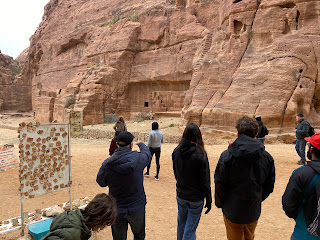






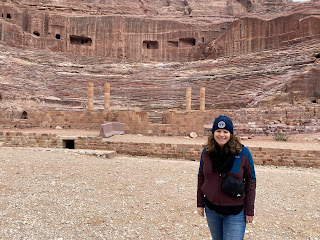

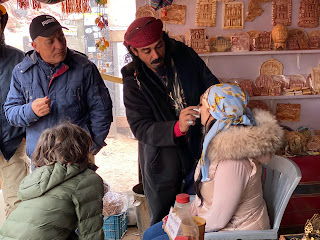












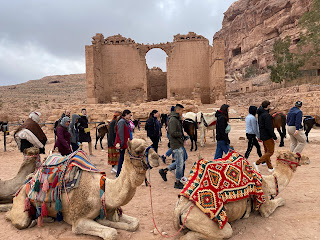



















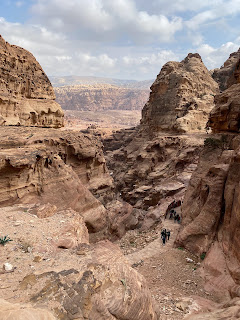






















No comments:
Post a Comment